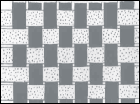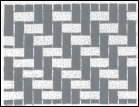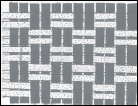























Check the fibres shown here. Again these are microscope images and show the shape and air-rapping potential of the fibres.
The first picture (1) is of cotton and shows the characteristic ‘close-packed’ look of most plant fibres.
Harder, and coarser - and with angular edges giving rough fibres are those of jute (2)
The pleasant soft feel of cashmere wool (3) is the result of the round fibres - whilst the thicker fibres of Marino wool (4) lead to the more durable qualities of the fabric made from them.
The first picture (1) is of cotton and shows the characteristic ‘close-
What do the fibres look like in the fabric you are using ?

Year 7 ~ Thinking about Textiles ....
Once made into single threads there are several different ‘weaves’ that used to make FABRICS. If you look closely at some of the materials that make up clothes you might find some of these different patterns into which the threads have been woven
Whilst you are making your products examine the material you are using under a magnifying glass. What do the fibres look like?
They will be woven in and out of one another to make the material you are sewing together but look closer.
Look at this picture here. It is one strand of wool seen under a microscope. Notice that there are a lot of spaces. These all trap air between them and it is this trapped air that makes wool so warm in winter.
They will be woven in and out of one another to make the material you are sewing together but look closer.
Look at this picture here. It is one strand of wool seen under a microscope. Notice that there are a lot of spaces. These all trap air between them and it is this trapped air that makes wool so warm in winter.

Wool
Silk
Flax
Cotton
Some interesting historical views on textiles and their production



Plain
Twill
Basket
Textiles and their Features


1
2
3
4

Why donate ?






